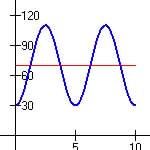Yes (repeats every 2)
Yes (repeats every period)
No (rises and fall with any repeats horizontal)
No (no consistent horizontal repeats)
Period, p = 40 (41 - 1 and 81 - 41, goes from 5 to 5)
Period, p = 4 (max to max, 4 - 0)
Max. = 24, Min = 4, and period = 2
So D = 14 and A = 10
Formula is 
Note 
So 2.75 cycles take 4(2.75) = 11 min.
Max. = 14, Min = 6 so D = 10 and A = 4.
The period, p = 1 sec
So spring oscillates from lowest to highest point in 0.5 seconds.
Graph A:  and
and
Graph B: 
(a) B is closest to ceiling when not in used since D = 10
(b) A makes the largest oscillation since A = 10
(c) A makes the fastest oscillation since 4 oscillations in same period as B.
Min = 30 deg C
Max. = 110 deg C
Lowest point when t = 0
P = 5 hours (time for 1 cycle)

